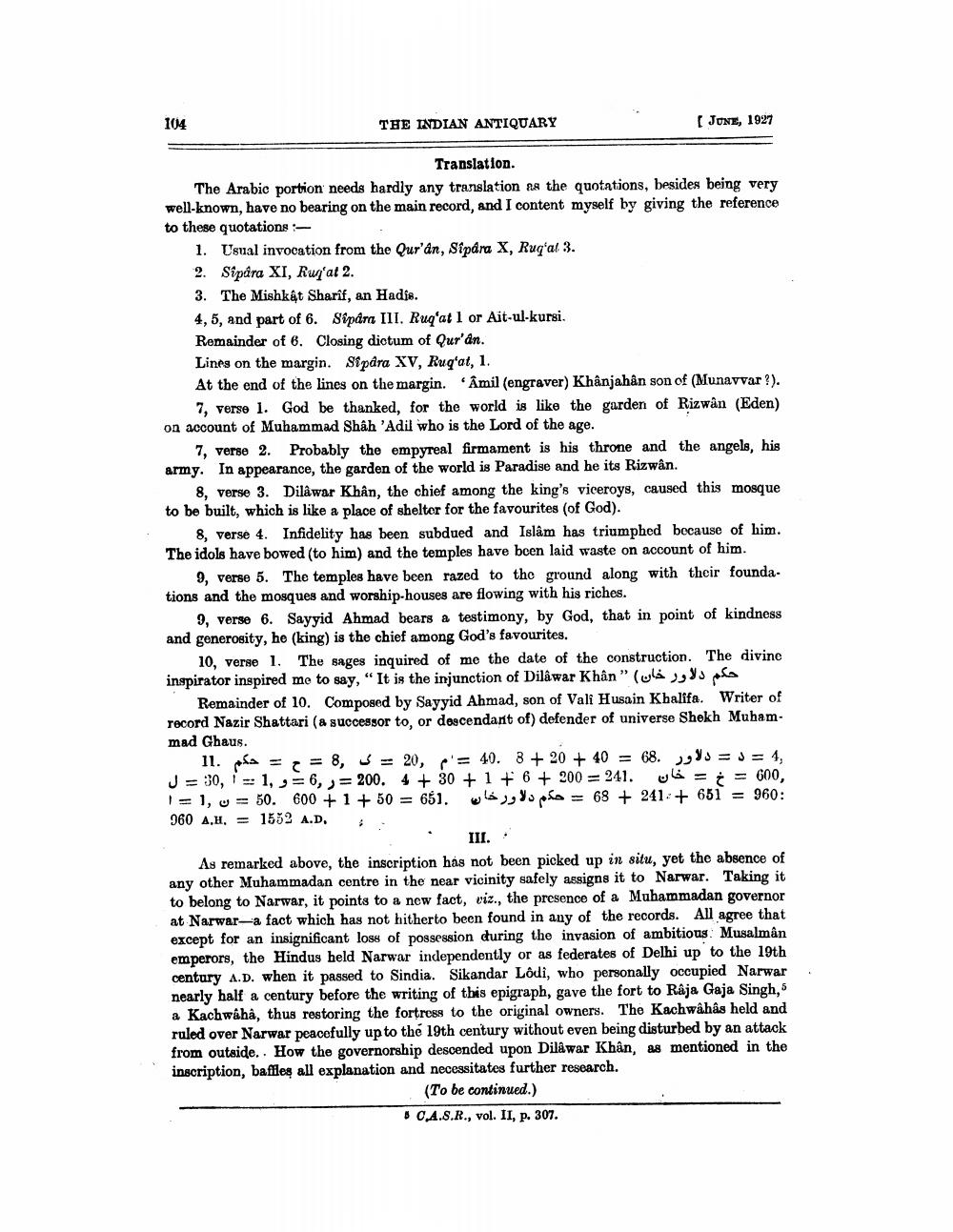________________
104
THE INDIAN ANTIQUARY
(JONE, 1927
Translation. The Arabic portion needs hardly any translation as the quotations, besides being very well-known, have no bearing on the main record, and I content myself by giving the reference to these quotations -
1. Usual invocation from the Qur'an, Sipdra X, Rug'al 3. 2. Sipára XI, Ruq'at 2. 3. The Mishket Sharif, an Hadis. 4, 5, and part of 6. Sipara III. Ruq'at I or Ait-ul-kursi. Remainder of 6. Closing dictum of Qur'an. Lines on the margin. Sipara XV, Ruq'at, 1. At the end of the lines on the margin. 'Amil (engraver) Khânjahân son of (Munavvar?).
7, verse 1. God be thanked, for the world is like the garden of Rizwan (Eden) on account of Muhammad Shah 'Adil who is the Lord of the age.
7, verse 2. Probably the empyreal firmament is his throne and the angels, his army. In appearance, the garden of the world is Paradise and he its Rizwan.
8. verse 3. Dilâwar Khân, the chief among the king's viceroys, caused this mosque to be built, which is like a place of shelter for the favourites (of God).
8, verse 4. Infidelity has been subdued and Islâm has triumphed because of him. The idols have bowed (to him) and the temples have been laid waste on account of him.
9, verse 5. The temples have been razed to the ground along with their foundations and the mosques and worship-houses are flowing with his riches.
9, verse 6. Sayyid Ahmad bears a testimony, by God, that in point of kindness and generosity, he (king) is the chief among God's favourites.
10, verse 1. The sages inquired of me the date of the construction. The divine inspirator inspired me to say, "It is the injunction of Dilâwar Khân" (ulás sa
Remainder of 10, Composed by Sayyid Ahmad, son of Vali Husain Khalifa. Writer of record Nazir Shattari (a successor to, or descendant of) defender of universe Shekh Muham. mad Ghaus.
11. a = = 8, = 20, '= 40.8 +20 + 40 = 68. 33=J= 4, J = 30,1 = 1,= 6,) = 200.4 + 30 +1 + 6 + 200 = 241. u = c = 600, 1 = 1, w = 50.600 + 1 + 50 = 651. wla SS = 68 + 241: + 651 = 960: 960 A.H. = 1552 A.D. i .
. III. As remarked above, the inscription has not been picked up in situ, yet the absence of any other Muhammadan centre in the near vicinity safely assigns it to Narwar. Taking it to belong to Narwar, it points to a new fact, viz., the presence of a Muhammadan governor at Narwar-a fact which has not hitherto been found in any of the records. All agree that except for an insignificant loss of possession during the invasion of ambitious. Musalman emperors, the Hindus held Narwar independently or as federates of Delhi up to the 19th century A.D. when it passed to Sindia. Sikandar Lodi, who personally occupied Narwar nearly half a century before the writing of this epigraph, gave the fort to Raja Gaja Singh, a Kachwahá, thus restoring the fortress to the original owners. The Kachwahas held and ruled over Narwar peacefully up to the 19th century without even being disturbed by an attack from outside.. How the governorship descended upon Dilawar Khân, as mentioned in the inscription, baffles all explanation and necessitates further research.
(To be continued.) 5 0,4.8.R., vol. II, p. 307.




